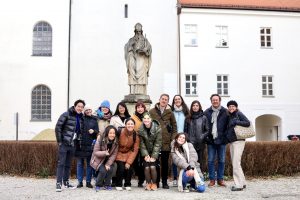
Photo Credit: Elia Zhang, Riggio Seminar in Freising, Germany.
Last spring break, I had the good fortune of participating in the Riggio Travel Seminar, a program offered to undergraduate students at Columbia University that enables them to study art history by visiting the sites where the artwork was created and preserved. In this blog post, I want to share my experience and encourage others to take advantage of the many learning and travel opportunities provided by Columbia.
After completing the university’s pre-departure orientation, our group of twelve students, accompanied by our teaching assistant Emma and professors Holger Klein and Gregory Bryda, embarked on the trip. Our first stop was Munich, where we visited the Odeonsplatz, the central square that connects old and new Munich and also served as the site of the Nazi march in 1923. We also saw the memorial for the White Rose movement, a nonviolent resistance group led by five students and one professor from Munich University who opposed the Nazi regime in 1942. We explored the old city center, seeing its inscriptions and architecture, which reminded us of the city’s 20th-century history.
In the afternoon, we visited Ludwigskirche, also known as Catholic Parish and University Church St. Louis. Its eclectic internal design, combining classical and Islamic influences, left us breathless, and the fresco above the central altar reminded us of Raphael’s work in the Stanza della Segnatura, which we had learned about in Art Humanities. We also visited St. Peter’s Church, which contained one of the most complete reliquaries we saw during the trip: a full skeleton preserved within a medieval altar. The architectural historian Dr. Katherine Boivin from Bard College, also a Columbia alumna, joined us at that point, and our discussion was greatly enriched by her expertise and enthusiasm. We spent the remainder of the afternoon at the baroque Asamkirche, studying its expressive design, which narrated history through meticulous details and iconography.
The next day, we visited the Bavarian National Museum, which housed a variety of treasures from Byzantine ivory and late medieval wood sculptures to Renaissance paintings. As an art history seminar, we spent an hour or more in front of each object we examined. In the afternoon, we took the train to Freising and visited the church of St. Benedict, Feising Cathedral, and Diözesanmuseum Freising. We spent hours discussing the churches’ interior and exterior structures, becoming more familiar with the terminologies to describe medieval architecture. One of my favorite stops was the Diözesanmuseum Freising, a modern museum whose exhibition followed a neat theme-based grouping of the objects and allowed contemporary artists to be in conversation with theological and aesthetic traditions.
Our third day began with Mass at the church of St. Michael, where we experienced the medieval ritual involving the concept of transubstantiation. In the afternoon, we visited Residenz München, where we examined the crowns of Emperor Henry II and his wife Cunigunde, as well as a giant rock crystal reliquary, in preparation for our next day’s visit to Bamburg. We spent hours gazing up at the cathedral’s portals, tracing the marks and cleavages on the stones, and trying to work out the architecture’s history, how it was built and revised over time. As a history major, I was used to learning from reading books, but this travel seminar solidified my understanding of material culture methodology as we examined the objects in person.
After a stop in Nuremberg on the fifth day of our trip, we continued on to Rothenburg, a beloved destination of many classmates. The town boasts a remarkably high preservation rate of its original medieval architecture, and wandering through its streets truly felt like stepping back in time. The highlight of our visit was the holy blood altarpiece at St. Jakob’s Church. This awe-inspiring work of art, crafted by Riemenschneider in his signature wooden monochrome style, was not only impressively large in scale but also cleverly interacted with the church’s interior structure. The theological significance of the altarpiece was further enhanced by the holy blood reliquary, which was preserved in a metal cross at the top of the piece. Perched above the unique bridge section of the church, the altarpiece exuded a mystical aura, seeming to protect both the town of Rothenburg and its natural surroundings.
Our final two days were spent in Würzburg, where Riemenschneider had his workshop, and Mainz, where we studied the Mainz Cathedral. Our trip not only provided us with a wealth of knowledge about medieval art but also allowed us to forge new bonds of friendship. We are deeply grateful for this unique learning opportunity and I encourage others to explore similar opportunities for learning, travel, fellowship, and funding in their respective fields.
